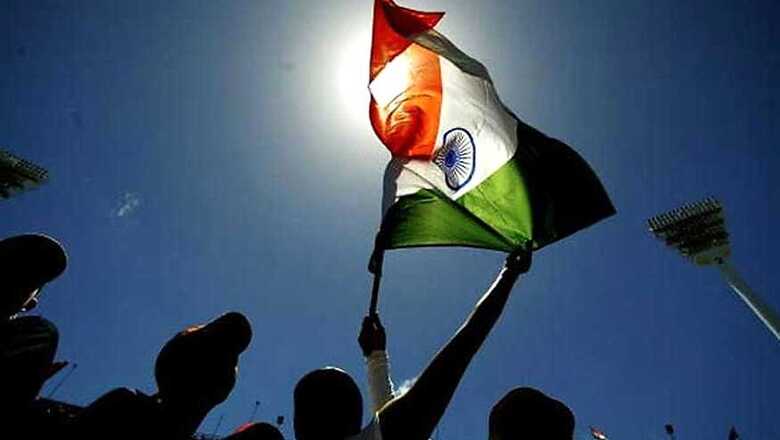
views
This year, June 7 will silently mark the victory of the Union of India and the resounding defeat of separatist forces. For the first time in 68 years, this day will not be celebrated as ‘State Flag Day’ in Jammu and Kashmir. The dream of Shyama Prasad Mookerjee, who fought for ‘Ek Pradhan, Ek Vidhan, Ek Nishan’, and of millions of Indians who wanted complete integration of Jammu and Kashmir, has finally come true.
On June 7, 1952, the Constituent Assembly of Jammu and Kashmir adopted the ‘state flag’ and hoisted it for the first time. It was officially celebrated as the ‘State Flag Day’ every year thereafter. No more. On August 5, 2019, when the Parliament of India rendered Article 370 ineffective and carved two Union Territories out of the erstwhile state of Jammu and Kashmir, both the state constitution and the state flag ceased to exist.
So it will be for the first time on June 7, 2020, that the state flag will not be found anywhere — on any building, on any vehicle, in any ceremony. It is just a relic of the past now.
Historical Perspective
The Delhi Agreement: Media often quotes the Delhi Agreement of 1952, an agreement between Prime Minister Jawaharlal Nehru and Sheikh Abdullah on behalf of Jammu & Kashmir. In the context of the state flag, it is quoted as follows: “The Union Government agreed that the State should have its own flag in addition to the Union flag, but it was agreed by the State Government that the State flag would not be a rival of the Union flag; it was also recognised that the Union flag should have the same status and position in Jammu and Kashmir as in the rest of India, but for historical reasons connected with the freedom struggle in the State, the need for continuance of the State flag was recognised”.
Here, we need to be clear that the Delhi Agreement was not a legal document signed between New Delhi and Srinagar, but simply an understanding between two leaders. On July 24, 1952, Nehru informed the Lok Sabha as to what had transpired between him and Sheikh Abdullah. However, no constitution order applicable to J&K was issued by the President of India to this effect. Therefore, the Lok Sabha statement of Prime Minister Nehru also had no legal or constitutional significance. According to some reports, while making a statement on Delhi Agreement even Nehru had described "the article an unusual provision and by no means final”.
Interestingly, there is no signed document of the Delhi Agreement available anywhere. Many experts and academicians have tried to locate a signed copy, but without success.
State Constitution: In 1956, J&K adopted a separate constitution, under which it was permitted to fly its own flag.
Article 144 of the now defunct Constitution of Jammu and Kashmir related exclusively to the Flag of the State, and stated: “The Flag of the State shall be rectangular in shape and red in colour with three equidistant white vertical strips of equal width next to the staff and a white plough in the middle with handle facing the strips. The ratio of the length of the Flag to its width shall be 3:2.” This was the full text of Article 144 and there was no other reference to the flag in the state constitution.
It is noteworthy here that the mischievous mind of Sheikh Abdullah had originally proposed to refer to J&K’s flag as the ‘National Flag of the Jammu and Kashmir state’ (during J&K Constituent Assembly debate). However the word ‘national’ was finally not included in the state constitution after legislator Mir Qasim proposed “That the words ‘National’ occurring before the word ‘Flag’ in the first line of the resolution be deleted”.
Controversies
Mischievous elements in Jammu and Kashmir (read separatist sympathisers) always thrived by creating controversies and confusing people about facts.
On March 12, 2015, such an attempt was made vis-à-vis the state flag. A government circular was issued directing all constitutional authorities to hoist both Union and State flag jointly on buildings and official cars. The circular created a furore. A day later, on March 13, the circular was withdrawn with another cryptic one-line circular.
The first circular referred to the Constitution of Jammu and Kashmir plus the Delhi Agreement of 1952 to make its point that the State Flag had to be hoisted along with the Union Flag. It went to the extent of warning that any deviation would amount to an insult to the State Flag. The second circular withdrew the first, but gave no reason whatsoever as to why it was being withdrawn.
On March 15, the withdrawal was challenged in J&K High Court. A petition was filed to requisition the High Court to direct the State Government not to withdraw the notification that had already been withdrawn.
A single judge of Jammu Kashmir High Court handed down a verdict that the flag shall be unfurled alongside the Indian Flag (Tricolour) on government buildings and cars of constitutional authorities. However, the Division Bench of J&K High Court promptly stayed the order of the Single Judge. The matter went nowhere after that, but did manage to create a storm in a teacup for a little while.
It is relevant to note here that Article 144 of the Jammu Kashmir Constitution simply specified the details of the state flag. It nowhere said that the flag had to sit next to the national flag.
On August 11, 1952, the Constituent Assembly of Jammu Kashmir itself had made it clear that the State Flag did not compete with the National Flag. The status of National Flag was higher than the State Flag. The Constituent Assembly of Jammu Kashmir recorded that: “..the new State Flag was in no sense rival of the National flag. But for historical and other reasons connected with the freedom struggle in the State, the need for continuance of this Flag was recognized. The Union Flag to which we continue our allegiance as part of the Union will occupy the supremely distinctive place in the State.”
Last year, the typical separatist ‘leaders’ in Kashmir tried to create a hue and cry when they were not given permission to hold functions on ‘state flag day’.
Now, the break-India lobby is left with one less reason to promote its agenda.
Shyama Prasad Mookerjee’s Dream
A freedom fighter and a cabinet minister in the first Union Cabinet of independent India headed by Prime Minister Jawaharlal Nehru, DrShyama Prasad Mookerjee had taken strong objection to the way the state of Jammu and Kashmir was being handled. He resigned from the union cabinet and the Indian National Congress due to these differences with Nehru.
Mookerjee, who founded Bharatiya Jan Sangh, supported the movement of the PrajaParishad in Jammu for full integration of the State of Jammu and Kashmir with the Indian Union.Mookerjee’s famous slogan“EkDesh Mein do vidhan/EkDesh Mein do Nishan/EkDesh Mein do Pradhan/NahinChalenge, NahinChalenge” had struck a chord with the people of India then, and continued to echo till August last year, when the mission was finally achieved. ‘Vidhan’ referred to the state constitution, ‘nishan’ to the state flag, and ‘pradhan’ to the post of ‘sadr-e-riyasat’ or prime minister that was granted to the head of J&K government then.
In May 1953, Mookerjee went to Jammu and Kashmir to take the integration movement forward, but was arrested the moment he set foot in the state. He died in Srinagar 40 days after being arrested, under mysterious circumstances.
Sixty seven years later, June 7 will sound a silent trumpet for Mookerjee’s final goal achieved!
The authors are senior journalists with expertise in issues related to Jammu and Kashmir. Views Expressed are Personal.


















Comments
0 comment